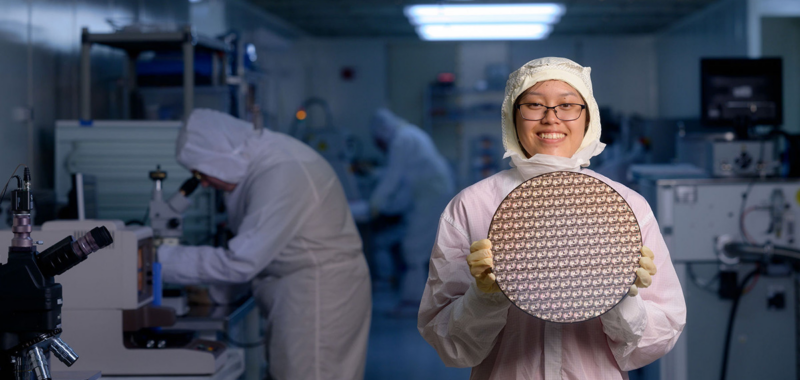
It’s a curious sign of the times that in our highly digitized and increasingly automated society, the demand for human workers has never been greater.
That’s especially true in the industry at the core of all digital technology—semiconductors.
Semiconductors, or chips, form the brains of modern electronics, powering technology as simple as washing machines and children’s toys, and as advanced as autonomous vehicles, spacecraft, and artificial intelligence.
Today, semiconductors are the most indispensable commodity around the world. “No product is more central to international trade than semiconductors,” Chris Miller wrote in his 2022 book Chip War: The Fight for the World’s Most Critical Technology.
Concern about the U.S.’s decades-long decline in its share of global semiconductor manufacturing has prompted bipartisan action at the highest levels of government.
CHIPS and Science Act
In 2022, the CHIPS and Science Act appropriated nearly $53 billion for semiconductor manufacturing, research and development, and workforce initiatives in the U.S. The law also established a 25% tax credit for capital investments in semiconductor manufacturing.
The law has sparked a semiconductor renaissance in the U.S.: 83 semiconductor ecosystem projects representing $447 billion in private investments and more than 56,000 jobs have been announced since the CHIPS Act took effect, according to the Semiconductor Industry Association (SIA).
Now the challenge for government, industry, and academia is to prepare the workforce to fill existing positions and anticipate the demand for future jobs. Of the roughly 115,000 new semiconductor jobs anticipated by 2030, more than half would go unfilled at the current rate of hiring, an alarming SIA report found in 2023.
U.S. Commerce Secretary Gina Raimondo made clear what’s at stake in a February 2023 speech: “If we don’t invest in America’s manufacturing workforce, it doesn’t matter how much we spend,” she said. “We will not succeed.”
In response, some states have sprung into action. The types of innovations and partnerships taking root in the U.S. are prevalent in Arizona, the state that’s attracted the most semiconductor investment.
A Robust Talent Pipeline
With its vast expanses of open land, booming population, and minimal natural disasters, the Grand Canyon State offers near-perfect conditions for advanced manufacturing to thrive. It also boasts a robust semiconductor presence, with an established talent pipeline and supply chain.
Arizona leads the nation in new semiconductor ecosystem investment, with more than $102 billion announced since the CHIPS Act took effect. During this time, companies have launched over 40 projects, generating more than 15,700 industry jobs.
The state uses its networks and education assets to launch its many training programs, such as the Semiconductor Technician Quick Start program, a 10-day, 40-hour boot camp taught by industry professionals. Upon completion, students are guaranteed a job interview at one of the state’s industry leaders, including TSMC and Intel.
Of more than 6,000 students who have submitted interest forms over the past two years, 4,000 have passed pre-assessment tests, and more than 900 have completed the program and been certified.
Arizona boasts one of the nation’s most robust pipelines for advanced degrees. Since 2011, engineering enrollment at Arizona’s public universities, which include Arizona State University (ASU), the University of Arizona, and Northern Arizona University, grew 230%, to more than 37,000 students in fall 2022. Programs supporting the semiconductor industry enroll more than 70% of these students.
More than 31,000 students enrolled at ASU’s Fulton Schools of Engineering in fall 2023. To help meet industry demand, ASU President Michael Crow has pledged to increase enrollment by 6,000 students by 2025.
State-of-the-Art Training
The state’s university training programs have drawn a major infusion of public and private funding, including $100 million from the state government, over the past year to boost semiconductor workforce development and research infrastructure. New initiatives include:
• Building a Materials-to-Fab Center at ASU in partnership with Applied Materials
• Growing advanced packaging and GaN capabilities in partnership with NXP Semiconductors
• Expanding the University of Arizona’s Micro/Nano Fabrication Center
• Launching a metrology training center and research network overseen by Northern Arizona University
The state will also support the expansion of a semiconductor registered apprenticeship program offering paid employment and training opportunities for semiconductor technicians at one of Arizona’s high-tech fabs while covering expenses like books and child care.
To help meet the scale and urgency of semiconductor industry needs, Arizona Governor Katie Hobbs recently announced a semiconductor workforce training accelerator in Maricopa County. Training at this state-of-the-art facility will take place in close collaboration with semiconductor industry partners, including Intel and TSMC, establishing first-of-their-kind training pathways to help more Arizonans enter the microelectronics industry.
The accelerator is modeled after a program Arizona launched for the automotive assembly industry, which has graduated more than 2,400 students since 2021.
The U.S.’s long-term semiconductor ambitions hinge on the collaboration between industry, government, and academia to create innovative and effective workforce training models. Arizona is leading the charge to address the U.S. semiconductor workforce challenge.
America’s economic, technological, and military interests, as well as its future place in the world, all revolve around tiny microchips. Designing, manufacturing, and assembling these chips require manpower, and a lot of it. Arizona is leading the charge to address the U.S. semiconductor workforce challenge.
Learn more about Arizona’s semiconductor advantages at: https://www.azcommerce.com/industries/manufacturing/semiconductor-advantages/

